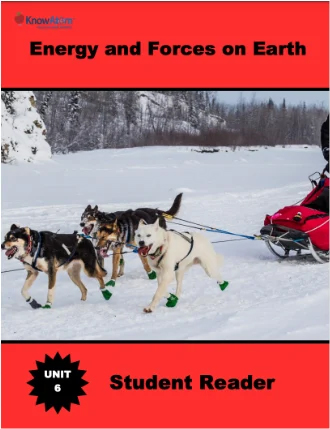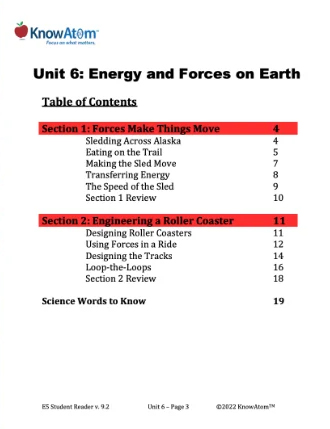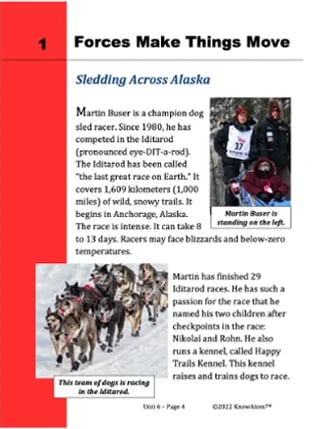Science background gives teachers more in-depth information about the friction phenomena students explore in this unit on energy and forces on Earth.
When engineers design technologies that move, such as dog sleds, they apply scientific knowledge about energy transfer and forces. This is especially important when designing roller coasters because at their core, roller coasters work because they are structured with gravity in mind.
Remember that gravity is the force of attraction between all matter, and Earth’s gravity pulls down on all objects on Earth’s surface. Roller coasters use the force of gravity to move along the track, converting energy from potential to kinetic and back again. At their heart, the design of roller coasters centers on the law of conservation of energy.
Let’s begin with the basic structure of a roller coaster. All roller coasters are made up of connected cars that move on tracks. But unlike a vehicle like a train, roller coasters don’t have a motor to make them move.
Instead, the cars are pulled to the top of the first hill, usually with a long chain that runs underneath the tracks. Together, the cars and the track form an energy system.
You may have noticed that the first hill of a roller coaster is always the tallest. This is done on purpose. As the roller coaster cars move up the hill, they are getting more potential energy. This form of potential energy is called gravitational energy, and it is the energy stored in an object as a result of its vertical position or height above the ground.
The higher up an object is, the more gravitational energy it has stored. The moment those roller coaster cars begin to move downhill, that gravitational energy changes to kinetic energy. As the cars move around the track, energy is constantly changing between potential and kinetic energy.
Gravitational potential energy changes to kinetic energy as the roller coaster cars begin to move down the hill. The first hill on a roller coaster has to be the highest because as the roller coaster cars move over the tracks, energy transfers out of the system. Friction is one force that transfers energy out of the system as the cars rub against the track.
Drag, also called air resistance, is another force that transfers energy out of a system. Drag is similar to friction, but it occurs between a solid substance and a fluid such as air. As the roller coaster cars move over the tracks, both friction and drag cause energy to transfer out of the roller coaster system. This means that the roller coaster has less energy at the end of the ride than it does at the beginning of the ride.
As you move over the tracks, it can feel as though forces are pulling your body in all directions. In fact, engineers design the track in a specific way so riders will feel the thrill of interacting forces. Remember that engineers use scientific knowledge and mathematics to solve problems by creating new technologies.
First, engineers know that Earth’s gravity is constantly pulling down on you. In response, the ground pushes back with an equal force. This is why we don’t all fall into the center of the planet. As you ride the roller coaster, gravity pulls down on you equally throughout the entire ride.
Engineers also know that objects in motion tend to stay in motion unless an outside force causes them to change their motion. This is called inertia.
For example, imagine that you are riding in one of the cars on a roller coaster. When the roller coaster accelerates, your seat pushes you forward. To accelerate means to increase your speed over time. As the roller coaster picks up speed, your body also accelerates.
When the roller coaster slows down, your body is still moving at that accelerated pace. The harness holding you in the car is the outside force that causes you to slow down. (This is the same function of a seatbelt in a car.) Roller coasters use changing accelerations and decelerations (decreases in speed over time) to make you feel weightless in one moment and extremely weighty in the next.
The feeling of weightlessness is a result of inertia and acceleration. It usually happens at the top of a hill, right at the moment when the cars begin to move downhill. At that point, the car is already moving downward, but because of inertia, your body hasn’t yet changed its motion downward.
For a brief moment, your body will lift out of the seat. In that second, gravity is pulling down on you, but the opposite force of the ground (or the car in this case) isn’t pushing back up. This is why you feel weightless.
Engineers also often design loop-the-loops to turn riders upside down for a few seconds in the middle of the ride. These loop-the-loops can result in the same feeling of weightlessness. The loop-the-loops are circular parts of the track. They work because of a force called the centripetal force. Centripetal force is a force that keeps an object moving along a curved path. As the cars move up and around the track, the centripetal force pushes them inward toward their center of rotation.








